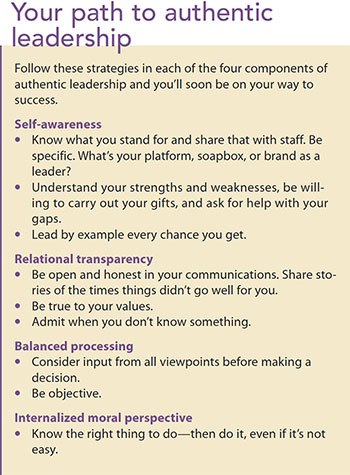By Greta Rosler, MSN, RN, NEA-BC, CPXP
Let your team know who you are and what you stand for.
Our trajectory as nurse leaders frequently begins when someone notices our clinical acumen and informal leadership skills. We’re handed a set of keys to an office and asked to take on a management role. Not surprisingly, we may question if we really know how to do every part of our expanding role, from budgets to quality metrics to program implementation and management focused on outcomes.
But a more important question to ask ourselves might be, “What drew me to nursing?” Was it a sick family member whose caregivers left such an impression that you had to follow? Or was it an innate desire to serve others? Perhaps a parent felt it was one way to ensure a stable future and encouraged your pursuit of the profession. This piece of what drew us to nursing is how we maintain focus and reconnect with those we lead. Ask yourself this: How do I show my team who I am as a nurse?
Authentic leadership


Authentic leadership is something we lose sight of on the journey to transformational leadership, but the elements of authenticity—self-awareness, relational transparency, internalized moral perspective, and balanced information processing—are key to that goal. (See Your path to authentic leadership.) Regardless of your personal inclination or strengths, achieving these four essential components centers around digging deeply into who we are as nurses and transitioning what we learn into what we stand for as leaders so we can share that with our followers. Although this might seem cerebral and abstract, there are tangible ways to accomplish it.
Direct communication
In an environment where new staff navigate an extensive (or in some cases, abbreviated) orientation process, we leaders rarely talk to them about what we value most on our floor or in our department. Your employee orientation process probably includes an explanation of organizational values for communication, a preceptor to teach skills and policies, a nurse-educator partnership to ensure the orientation adheres to regulations, and human resources instruction about attendance and benefits.
But do you sit down with new staff to talk about the importance of monitoring intake and output of postoperative surgical patients and your expectations for behavior in the emergency department and between peers? Have you shared what you’ve learned will matter most in patient interactions and your expectations for eye contact?
New nurses deserve to hear directly from you. This conversation, during which you let them know that you were once in their shoes, leads to relational transparency for you as an authentic leader. Being an inspirational culture builder who’s a servant to his or her staff sounds out of touch to many. But sitting down with your team to explain that every patient who underwent bowel-resection surgery should get a straw for his or her broth without having to ask for it, isn’t.


In systems where we aspire to best-in-class outcomes and retention, we offer layer upon layer of information and expect our team members to thrive. Since most people need to hear something seven to 10 times to absorb it, shouldn’t your staff hear it at least once from you? Authentic leadership isn’t as out of reach as we think; it can be as easy as a series of planned, short meetings with new employees to review specific (not broad) key points. This approach will help you reap huge dividends in terms of retention, quality, and engagement.
Don’t make assumptions
Authentic leadership is essential to our continued evolution as leaders. But many of us overlook this concept in the day-to-day routine of leading unit meetings to discuss new policies, writing educational updates to keep the team accountable in their roles, and working with dashboards to track and trend where we’re headed. Authenticity is in all of us as leaders, regardless of our specialty, education, or the electronic tools we have or can’t acquire, but it’s rarely spoken about in nursing because we assume that we know who we are as leaders and that our staff members know what we stand for. But how can they if we don’t tell them?
Greta Rosler is the director of patient experience at Geisinger Community Medical Center in Scranton, Pennsylvania, and president and owner of Radius Leaders, a leadership development, coaching, and consulting company.
Selected references
Avolio BJ, Gardner WL, Walumbwa FO, Luthans F, May DR. Unlocking the mask: A look at the process by which authentic leaders impac follower attitudes and behaviors. Leadersh Q. 2004;15(6):801-23.
Bamford M, Wong CA, Laschinger H. The influence of authentic leadership and areas of worklife on work engagement of registered nurses. J Nurs Manag. 2013;21(3):529-40.
Gray LR. Nurse manager engagement: A concept analysis. Nurs Forum. 2012;47(3):193-9.
ant2-Authentic Leadership-124


















